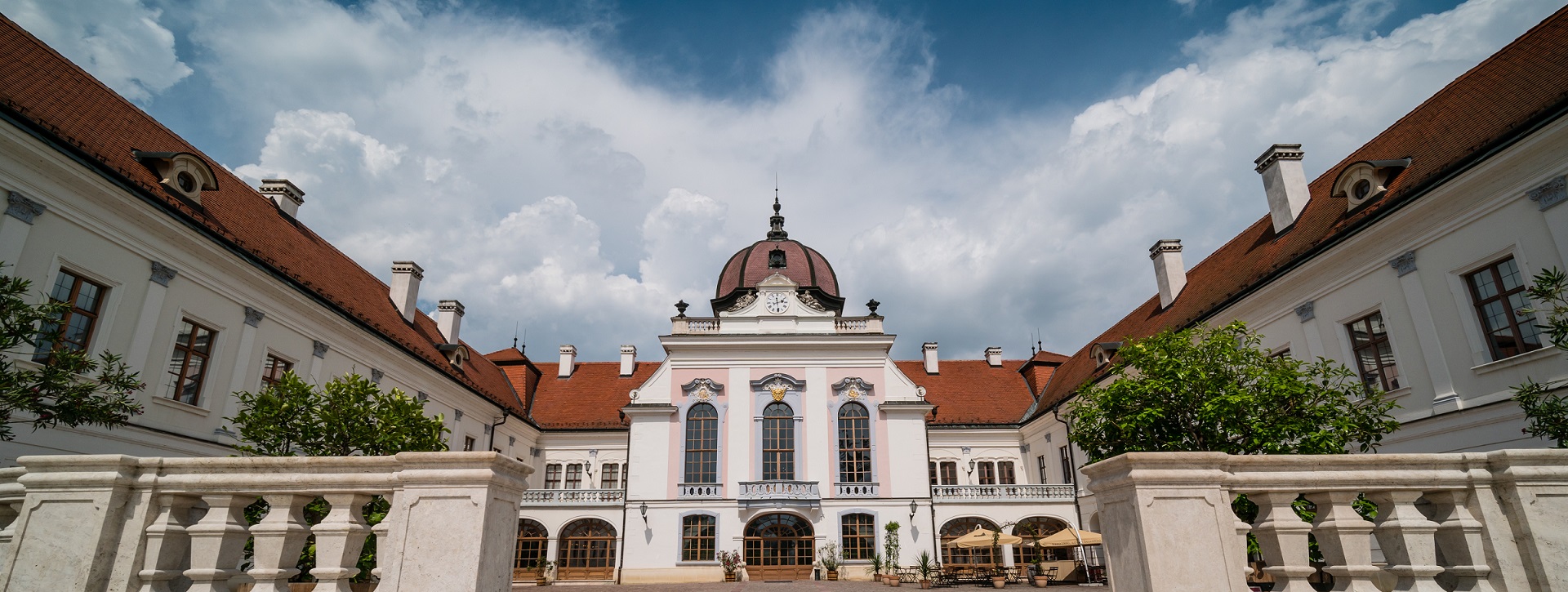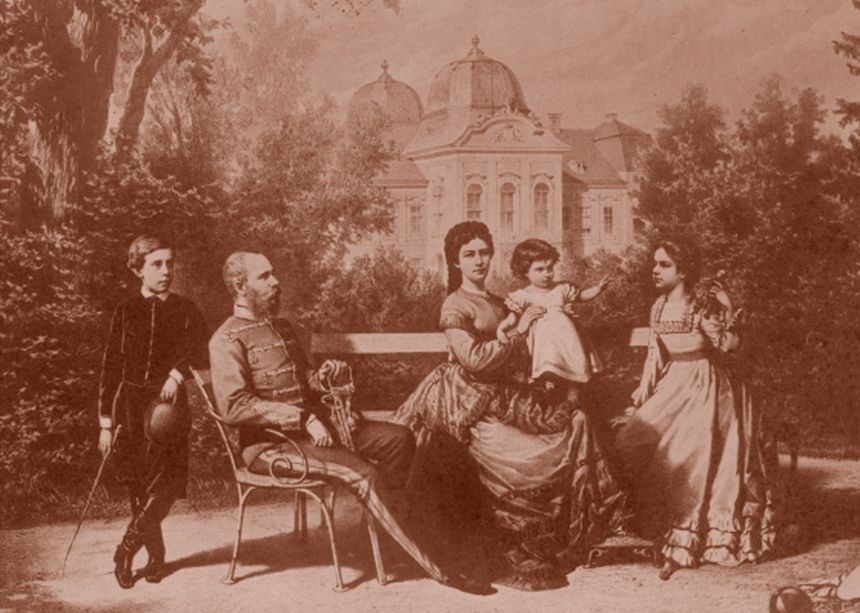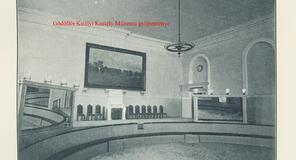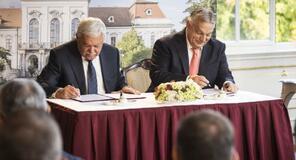
 The first time that Elizabeth visited the Gödöllő palace, which was offered as Coronation gift to Elizabeth and Francis Joseph I, was on 11 May 1867. Francis Joseph I was obliged by his coronation oath, taken in 1867, to spend regular periods of time in Hungary. To this end, the Hungarian government wished to please the royal couple by placing at their disposal not only the Castle in Buda as political headquarters, but also residences in the countryside suitable for relaxation. Of these, however, only the plan for Gödöllő came to fruition.
The first time that Elizabeth visited the Gödöllő palace, which was offered as Coronation gift to Elizabeth and Francis Joseph I, was on 11 May 1867. Francis Joseph I was obliged by his coronation oath, taken in 1867, to spend regular periods of time in Hungary. To this end, the Hungarian government wished to please the royal couple by placing at their disposal not only the Castle in Buda as political headquarters, but also residences in the countryside suitable for relaxation. Of these, however, only the plan for Gödöllő came to fruition.
Count Antal Grassalkovich I (1694–1771), one of the most notable aristocrats of the 18th century, began construction of the largest Baroque palace in Hungary around 1735. After his family died out it had several owners before being bought by the Hungarian government in 1867. Following a quick reconstruction the Palace and the park were placed at the disposal of Francis Joseph and Elisabeth as a coronation gift.
The Palace had 136 rooms altogether, of which 103 were living rooms, 67 of these being for the staff. Royal suites were established in the main building, to the north and south of the ceremonial hall. Comfort rather than grandeur was the main aim. The walls of the king’s apartment were covered with yellow panelling and grey silk wallpaper. The queen’s suite was characterised by her favourite colour, violet. Both were later changed to white, red and gold. Elisabeth’s suite consisted of a salon and writing-, bed-, dressing-, and reading rooms. A spiral staircase led from the upper floor to the three-room suite on the ground floor. Next to Elisabeth’s rooms was the suite of her reader Ida Ferenczy, followed by the rooms of the royal children.
The Baroque theatre fell victim to alterations made in the royal period. It was replaced by 15 rooms. (For example, Rudolph’s rooms were brought here when Marie Valerie was born.) A building for the major-domo was erected in the south section and the coach-house was extended by further stables. The Palace was surrounded by an English landscape garden, with two swan-ponds in front of the main facade.
The first time the royal family visited the Palace was in the autumn of 1867. From this time on they would spend several months a year here, mainly in the spring and autumn. Gödöllő soon became a favourite spot for Elisabeth where she found refuge from the protocol in Vienna. ‘Here you can get a bit of peace, no relatives, no-one bothering you, whilst there, in Vienna, there’s the whole imperial crowd! There’s nothing to annoy or constrain me here, I can live like in a village, and I can walk or ride out on my own!’ - as Elisabeth wrote to her mother from Gödöllő.
It was, in fact, the perfect spot for all her favourite pastimes. If she sought solitude no-one disturbed her: she could read, learn languages, write or walk as she liked. As Ferenc Ripka, the royal monographer of the time put it: ‘When the locals, who adored Queen Elisabeth, caught sight of her elegant figure dressed in black, they would respectfully keep out of her way, because they knew that Her Majesty does not like impertinent curiosity.’ If she desired company, grandiose horse races, hunts, greyhound races or pigeon-shooting were arranged for her. The Hungarian equestrian elite, Count Gyula Andrássy among them, frequently paid visits here. The King did not spend much time on fun or relaxation. He was extraordinarily hard-working and his sense of duty made him work from early morning till night with short breaks for walks or meals. He also took part in hunts, mainly for shooting big game. His suite and the staircase at Gödöllő were adorned by his trophies.
The queen had always been attracted to unusual, unconventional things. She loved Gipsy music, even hosting full Gipsy bands in the Palace on a number of occasions. Much excitement and bewilderment was caused by another of her ideas: Marie Valerie had a crippled Saracen boy as a playmate. Rustimo was a gift from the Shah of Persia.
In Gödöllő, everyday life and holidays were much more casual and relaxed than in Vienna. In the autumn season, the locals celebrated the queen’s nameday (19 November) with a serenade and a torch-lit procession. Christmases were very intimate, as mentioned by Marie Valerie’s tutor, Jácint Rónay in his memoirs: ‘In the evenings they played blind man’s buff at the desire of Marie Valerie, then they got busy again, colouring and cutting out figures for the picture book the kind-hearted princess wanted to give to the little patients in the children’s hospital.’ Holidays always presented an opportunity for exercising charity. The family frequently stayed on in Gödöllő till the New Year. Another note by Rónay from 1881: ‘On New Year’s Eve, the Christmas tree was once again dressed in festive splendour. In a corner of the upper garden an artificial skating rink was set up, where the princess and her close friend, Duchess Aglája Auersperg would skate happily all day long.’
The Queen spent a total of 2663 days (7.3 years!) in Hungary, of which 2000 were spent in Buda and Gödöllő. She last visited here in October 1895. Following her death in 1898, the king visited Gödöllő much less frequently. To commemorate their beloved Queen, Hungarians have erected more than 40 monuments and established 100 memorial gardens and groves in the country. The first of these parks was the one in Gödöllő, dedicated in 1901 with a full-length statue of the queen. The town is still the number one centre of the cult of Queen Elisabeth.
Ildikó Faludi


